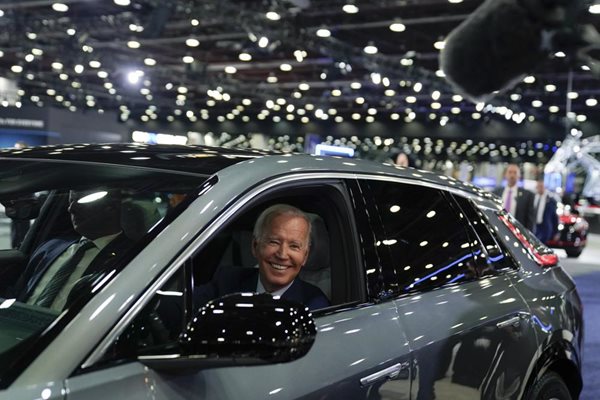President Joe Biden, a self-described “car guy,″ often promises to lead by example on climate change by moving swiftly to convert the sprawling U.S. government fleet to zero-emission electric vehicles. But efforts to eliminate gas-powered vehicles from the fleet have lagged.
Biden last year directed the U.S. government to purchase only American-made, zero-emission passenger cars by 2027 and electric versions of other vehicles by 2035.
The White House frequently describes the timeline as on track. But the General Services Administration, the agency that purchases two-thirds of the 656,000-vehicle federal fleet, says there are no guarantees.
Then there is the U.S. Postal Service, which owns the remaining one-third of the federal fleet. After initially balking and facing lawsuits, the agency now says that half of its initial purchase of 50,000 next-generation vehicles will be powered by electricity. The first set of postal vehicles will hit delivery routes late next year.
Electrification of the federal fleet is a “cornerstone” of Biden’s efforts to decarbonize the federal government, said Andrew Mayock, chief federal sustainability officer for the White House.
Excluding the Postal Service, about 13% of new light-duty vehicles purchased across the government this year, or about 3,550, were “zero emissions,” according to administration figures provided to The Associated Press.
Nationwide, about 6% of new car sales are electric.
When it comes to vehicles actually on the road, the federal numbers are even smaller. Many of the purchases in recent months won’t be delivered for as long as a year due to supply chain problems.
Currently just 1,799 of the 656,000-vehicle federal fleet are zero-emissions vehicles.
At a rate of 35,000 to 50,000 GSA car purchases a year, it will take years, if not decades, to convert the entire fleet.
The GSA pointed to a limited EV supply from automakers with big upfront costs. Agencies also need easy access to public EV charging stations. The White House has acknowledged agencies are “way behind” on their own charging infrastructure, with roughly 600 charging stations and 2,000 total chargers nationwide.
While the Postal Service is an independent agency, it plays an essential role in fleet electrification, not only because it owns 234,000 vehicles in the federal fleet, but also because the familiar blue-and-white mail trucks are by far the most visible federal vehicle, rolling into neighborhoods across America each day.
The agency plans to buy up to 165,000 of next-generation vehicles over a decade. The Postal Service remains “committed to reducing our carbon footprint in many areas of our operations and expanding the use of EVs in our fleet is a priority,″ said spokesperson Kim Frum.
President Joe Biden drives a Cadillac Lyriq through the showroom during a tour at the Detroit Auto Show, Sept. 14, 2022, in Detroit. Biden, a self-described “car guy,'' often promises to lead by example by moving swiftly to convert the sprawling federal fleet to zero-emission electric vehicles. But efforts to help meet his ambitious climate goals by eliminating gas-powered vehicles from the federal fleet have lagged. (AP Photo/Evan Vucci,
Advertisement
Biden pledge to electrify federal fleet faces slow start
Advertisement
Latest State & National
State & National
an hour ago
State & National
7 hours ago
State & National
13 hours ago
State & National
yesterday
State & National
yesterday
ADVERTISEMENT
Most Read >
ADVERTISEMENT
Latest State & National
State & National
an hour ago
State & National
7 hours ago
State & National
13 hours ago
State & National
yesterday
State & National
yesterday
Advertisement
ADVERTISEMENT





